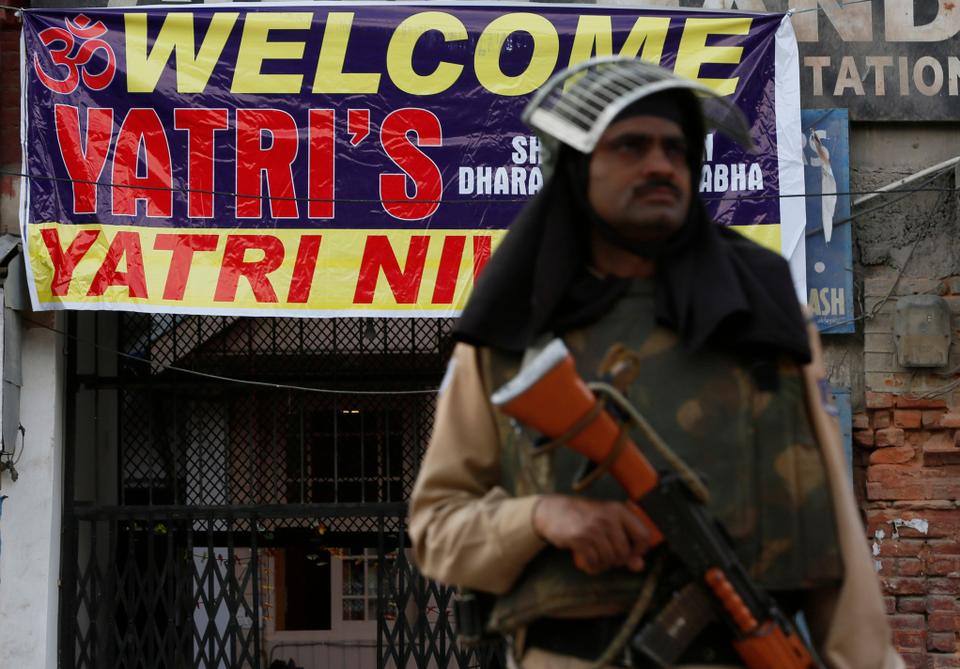The Indian government has come under criticism for taking advantage of a spiritual journey to meet political ends.
From a distance, several Indian soldiers blow whistles and wave their right hands frantically while holding AK-47 assault rifles chained to their bodies on the left. This is an order for all vehicles to pull over and stop on the main highway that links India-administered Kashmir to the rest of the world.
The ritual is familiar to the regular commuters, many of whom grow restive and start cursing the Indian state that has, in the recent months, unleashed a series of repressive tactics to contain the 30-year-old popular insurgency.
Until May 30, the civilian vehicles stopped would only be let go once a convoy of army vehicles had barrelled along the opposite side of the road, a measure imposed after a Kashmiri suicide bomber rammed an explosives-laden car into a paramilitary convoy on February 14, killing 40 Indian soldiers. After much public outrage, the diktat was withdrawn.
An Indian tourist walks up to a soldier and asks him why the vehicles have been stopped and for how long. Kashmiris are well aware of the reasons, which would soon become clear.
“A convoy is coming,” the soldier says and the tourist goes back to his car.
The word “convoy” in the highest-militarised zone in the world usually refers to a long line of Indian army trucks. Half an hour passes but no convoy is in sight. The line of the halted vehicles grows longer in the meantime. Many commuters told me the line was shorter compared to the previous days —when it would be more than a mile long — because it was a holiday.
The summer heat turns vehicles into furnaces and many travellers get out, but the sun, which throws harsher light at high altitudes, drives them back into their vehicles.
After about 75 minutes, the convoy appears. First a few security vehicles, then buses, SUVs, cars and taxis whose registration plates giving away the places they belong to — HR (Haryana), RJ (Rajasthan), UP (Uttar Pradesh), names of north Indian states. A vehicle fitted with IED-jamming device is sandwiched in between.
The vehicles carry Indian pilgrims headed for Amarnath cave, where a phallus-shaped stalagmite is formed during May and melts by August. Hindus believe this naturally forming ice linga represents Lord Shiva. The nearest of the two routes to the mountainous cave is about 100 kilometres from the spot where the traffic has been stopped, a place called Qazigund.
A few cars that break out of the line are allowed to proceed towards the Indian mainland because they carry the Indian pilgrims who were returning after glimpsing the ice lingam. Kashmiri travellers fume.
“They would deprive us of oxygen if they could control it,” said a Kashmiri youth, Javed, a frequent commuter on this highway.
A soldier said that on average 400-600 pilgrims’ vehicles pass on this highway each day. Each time, traffic comes to a standstill until they reach their destinations, ironically named as the “base camps” of Nunwan and Baltal. The final leg of the pilgrimage, mostly by foot, begins from these two places.
No civilian can cross the raised footpath dividing the highway when the pilgrim vehicles pass by. All major roads leading to villages and towns along the highway are blocked by soldiers or armoured vehicles during this time. Civilian traffic is barred for five hours (now reduced to two) on a stretch of the highway in Jammu region.
Some pilgrims film the fabled natural beauty of the place with their mobile phones and some chant slogans for the Shiva. At some places, they have been heard shouting provocative political slogans. They greet the soldiers whose relationship with the locals is anything but cordial.
As many as 40,000 soldiers are deployed exclusively for the security of the pilgrims or yatris along the routes and around pilgrim camps and community kitchens, making this annual journey one of the most militarised affairs. Tens of hundreds of policemen perform other related duties.
Local residents said that the pilgrims are accommodated in several security camps along the highway for a specified time— sometimes overnight if they arrive late in the Valley —before heading towards the cave.
In Shompora, Qazigund, about 100 metres away from the place where the civilian vehicles were stopped, a six-acre security camp currently doubles as a transit camp for the pilgrims. Pre-fabricated rows of huts have been built to accommodate the yatris who, the local residents said, sing religious songs during the night.
Ghulam Nabi Mir, who runs a grocery shop near the camp, said the traffic stops have become a nightmare.
“Yesterday a woman came to my shop and requested if she could sit here for a while. She was travelling in a taxi which was stopped when the yatri buses passed by and her six-month-old baby wouldn’t stop crying because of the heat in the vehicle. The ceiling fan in my shop calmed the baby. Zulm haez zulm (it’s nothing but oppression),” said Mir.
He added that his daughter, who is studying in a college in Anantnag town, about 20km away, had skipped her classes for three of the five days since July 1, when the 45-day yatra began.
Above his shop is a building housing Ali Memorial School, which has a register of about 500 primary students who reside in about half-a-dozen neighbouring villages. Asghar Ali Bhat, who drives one of several buses of the school, said schoolchildren get no relaxation during the “convoy” movement.
“Children invariably reach late to the school. A day before yesterday when they stopped traffic we told them [the soldiers] let the children walk to the school because it is hot inside vehicles. Sensing that so many children walking the highway was fraught with danger they let us go but only after about an hour,” he said.
The pilgrims bound for the traditional route to the cave via the tourist hub called Pahalgam are first accommodated in a massive government granary at Mir Bazar in Anantnag town, the largest in southern part of the Valley. From the storage facility, they are ferried to Nunwan base camp at about 3pm every day.
This reporter reached Anantnag town at around that time to catch up with the pilgrims. Soldiers didn’t let any vehicle to stop or park by the otherwise congested road.
By now the ritual is familiar to the shopkeepers, who are seething with anger and complaining the business has been hit.
“Why would someone drive to this market and suffer the ordeal?” said Altaf, who runs a shop along KP Road in Anantnag.
As the time for the convoy nears, soldiers grow animated. Nearly all of them blow whistles, as if in an orchestra, signalling people to drive on. Aware of the stops, a few cars rev up the accelerator to the maximum so that they can take a detour. A soldier steps into the middle of the road and raises his assault rifle.
The convoy arrives and leaves the area relatively quickly. While it passes by, four to five army jeeps drive parallel to it on the facing road. A little ahead, where the road forks, civilian vehicles have been stopped. A man gets out of his car and cools off his feet in what used to be an irrigation canal. Many other commuters do the same. A young girl in a passenger taxi wipes sweat off her forehead, and looks with embarrassment at the people around.
Catching up with the pilgrims again at Sarbal, about 500 metres from Nunwan base camp in Pahalgam, the major tourist destination in southern Kashmir where local residents avoid going at this time of the year because of security and traffic stops, every traveller, including the pilgrims, is frisked at a massive checkpoint.
The weather turns cloudy and it starts to rain, bringing some relief to the travellers. The pilgrims praise Lord Shiva.
The yatra was not always a security-centric Hindu nationalistic project it has become. The cave itself is believed to have been discovered by a Muslim shepherd, Buta Malik, whose descendants performed Hindu rituals at the sanctum sanctorum alongside Hindu priests from two local religious organisations. But Maliks and the organisations were ousted by a Hindu religious board, which was formed in 2000.
The board was ensnared in political controversy when, without consulting the local government, it extended the period of the pilgrimage from 15 days to the current 45 days. A clandestine transfer of virgin forested land to the board in 2008 by an Indian bureaucrat led to the first of the three mass uprisings in Kashmir, the others taking place in 2010 and 2016.
It is not clear when the pilgrimage started. But until 1990, when the anti-India insurgency started in Kashmir region, which is more than 95 per cent Muslim, the pilgrimage was a very low-key affair, involving a few hundred Hindu godmen and other people.
After Hindu extremists destroyed a medieval mosque in India, a militant outfit, which doesn’t exist anymore, announced a ban on the yatra, in which a sizeable number of local Muslims provide horses, tents and also carry the elderly pilgrims on their shoulders on the treacherous 14 or 36 kilometre trek to the cave. The separatist leadership did not endorse the ban.
Despite several attacks on the pilgrims in the past 30 years by insurgents that have killed more than 40 people, the yatra never witnessed such a scale of militarisation as today.
On Monday, Governor of Jammu and Kashmir Satya Pal Malik told the media that “people should bear with traffic restrictions for the sake of pilgrims’ security”. The day the yatra began, he said the smooth conduct of the pilgrimage had been made possible more by Kashmiris than security forces.
For local Kashmiris, the yatra has become an important tool in the Indian state’s myriad strategies to blunt the overwhelming pro-freedom and pro-Pakistan sentiment in Kashmir. The larger goal behind making the pilgrimage bigger—110,000 pilgrims visited the cave in only eight days this year— each passing year, according to one analyst, seems to turn Kashmir into a non-negotiable sacred land.
The shrine board, which manages the yatra, has paid no heed to expert recommendations calling for limiting the number of pilgrims from 1,000-5,000 a day. The board sends 18,000 a day to the cave by foot and helicopter. A study by a civil society group, titled Amarnath: a Militarized Pilgrimage, says that on any given day, there are about 50,000-60,000 people (when security personnel and service providers are added) on either of the two routes leading to the cave.
Also unheeded have been environmental concerns. Tons of human and other waste is littered along the yatra route, some of which seeps into the river nearby and leads to a spurt in the cases of water-borne diseases among the local residents, especially after the pilgrimage ends. Roads and concrete buildings have been constructed in pristine forests and mountains.
But more than environmental factors, the deepening religious fault lines are a matter of concern. Pilgrim vehicles have been spared the $1.2 toll tax on the highway. The government had declined the local business community’s request for a toll waiver recently at a time when the local economy has suffered because of the volatile situation.
Source – https://www.trtworld.com/magazine/how-a-hindu-pilgrimage-became-militarised-in-disputed-kashmir-28127?fbclid=IwAR0T5bb1RSeR1ROhXLHf_0rpuPfOrnAXz7ep-Km-3wKfRAu6oS1PpuStuW0




